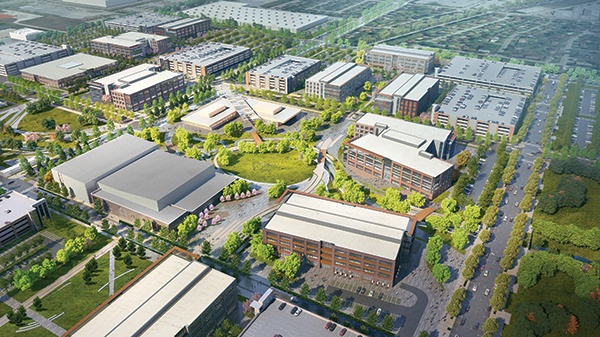Walmart rethinking use of new home office; technology teams to continue working remotely
by June 3, 2020 12:39 pm 26,893 views

Walmart's planned new campus in Bentonville will span 20 buildings, with the Razorback Regional Greenway running through the center of the campus.
COVID-19 has prompted Walmart to rethink usage of the new corporate home office design and some divisions will likely continue to work remotely. President and CEO Doug McMillon said Wednesday (June 3), “we are going to still need office space in a post-pandemic era.”
Walmart first announced in September 2017 plans to build a new corporate headquarters campus near the existing headquarters in Bentonville that will provide space for between 14,000 and 17,000 employees. The project will be built in phases, and company officials said at the time that construction would take between 5 to 7 years. The development plan encompasses a 350-acre site that includes several existing buildings that have been razed or will need to be. Walmart has not disclosed a cost for the project.
Dan Bartlett, head of corporate affairs at Walmart, told shareholders on Wednesday the new home office in Bentonville will likely be based on the future ways of working. He said Walmart is still in the design phase of the massive project the retailer is looking at this new normal and the buildings will have maximum flexibility. He said Walmart will seek best practices for life in a post-pandemic world. The new campus is a multi-year project and Bartlett said Walmart is fortunate to be in early design phases where changes and updates can be made.
McMillon said Walmart “is always going to need office space” for some divisions and for collaboration. One particular challenge he has seen with working remotely is the “difficulty in onboarding a new associate.” He said Walmart’s culture is important and it can best endure when people are present with others. McMillon said while some divisions will continue to work remotely, most will return to their offices as the pandemic impact subsides.
The statements by McMillon and Bartlett come on the heels of an internal memo issued late last week by Suresh Kumar, global technology officer at Walmart. Kumar said the around 10,000 technology employees located in Silicon Valley (California) and the David Glass Technology Center in Bentonville will continue to work from home indefinitely. When the pandemic hit, he said technology teams at Walmart adjusted well to working remotely.
“As we’ve moved to virtual work, we haven’t just coped, we’ve actually thrived. We are more focused on the things that have the greatest impact for our customers, associates and the business. We are making quicker decisions and actions. Meetings are now more inclusive of people regardless of location, level, or other differences. We have great momentum and need to figure out how to carry it forward,” Kumar said.
Kumar said Walmart sees this as the new normal for the tech division. He said even as restrictions are lifted and other groups in Walmart return their offices, the tech division will think about how the workspace can be reinvented for the future.
“We will have physical office space and it will be used primarily for collaboration, to sync up and strengthen camaraderie. We’ll be together, at times, and for a purpose. While we believe working virtually will likely be the new normal, we have a lot to work through to make sure we maintain our momentum and the benefits you’ve gained as an associate,” he said in the memo.
A recent Brookings Institution report indicates many companies may reassess their workplace needs.
“Between 2005 and 2015, the fraction of workers who regularly worked from home increased by only about 2 to 3 percentage points, according to Mas and Pallais (2020). Even at that growth rate, telecommuting has been the fastest-growing method of commuting over the last several years. If our new telecommuting culture sticks, the pandemic will have accelerated this trend dramatically. Already, nearly one in five chief financial officers surveyed last week said they planned to keep at least 20% of their workforce working remotely to cut costs.”
